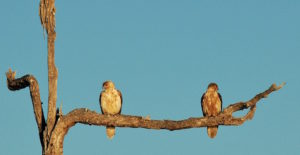Fishing equipment is the deadliest threat faced by coastal birds of prey a new study published in the Journal of Raptor Research has found.
Researchers from Griffith and Charles Darwin Universities analysed 22 years’ worth of data on Australia’s coastal raptors (White-bellied Sea-Eagle, Eastern Osprey, Brahminy Kite and Whistling Kite) arriving at the Currumbin Wildlife Hospital and what they found was surprising.

Lead author Vicky Thomson, a PhD candidate at the Environmental Futures Research Centre and founder of Coastal Raptors of Australia.
“Since birds of prey live alongside humans in urban areas, these four species faced a host of threats both human-made and natural including car strike and attack from other urban birds,” said lead author Vicky Thomson, a PhD candidate at the Environmental Futures Research Centre and founder of Coastal Raptors of Australia.
“What was surprising, however, was that fishing equipment entanglement was the most identifiable threat in this part of the country.
“While vehicle strikes, building collisions, and even electrocution by powerlines are common in an urban environment, most people don’t think about the devastating impact the waste from their fishing trip can have on birds of prey. The Gold Coast has the highest rates of discarded fishing equipment in Australia.”
These species, commonly found around the marine parks and coastal areas of the Gold Coast and Brisbane, are known to scavenge fish and line their nests with discarded human materials.
“My co-authors and I have seen these charismatic birds of prey actually seek people out for food! They quickly learn where to go to get a free feed, however, remain oblivious of the consequences, becoming entangled in fishing line and impaled by discarded hooks,” Ms Thomson said.
“Such encounters with the lost and discarded lines and hooks of a quick fishing trip can often result in tragic consequences for our birds of prey, like the amputation of a foot, damaged wings, ingested hooks, and even death.”
Co-author Professor Emeritus Darryl Jones, with the Environmental Futures Research Instituteand the School of Environment & Science, said the loss or injury of coastal birds of prey was almost completely avoidable if we change our behaviour and adopt the fishing practices set out by Government authorities.
“By never leaving your fishing line, hooks, bait and packaging behind or alone when fishing, always cleaning up responsibly and not using illegal fishing methods, we could prevent many of the incidents that bring these birds to the Currumbin Wildlife Hospital.”

“The Currumbin Wildlife Hospital treats and rehabilitates around 200 raptors every year,” said senior vet Dr Michael Pyne.
“For the moment, wildlife hospitals and rehabilitation centres like CWH, which are reliant on public donations for their own survival, are crucial in treating and rehabilitating thousands of birds of prey across Australia every year.”
“This research project with the Currumbin Wildlife hospital is a great example of how university scientists can discover really important details that over-worked wildlife vets simply don’t have time to do,” Professor Jones said.
“By forming these types or research partnerships and working together we learn a lot more about the impact we are having on these amazing birds and what we can to minimise it.”
Measures such as specialised tackle bins are helping to create much-needed awareness of the dangers of fishing equipment entanglement.
“So we encourage the public to pick up any discarded fishing equipment they come across and dispose of it in a bin,” Ms Thomson said.
“And if you do come across an injured or entangled bird, call your local wildlife rescue group or wildlife hospital as soon as possible.”

